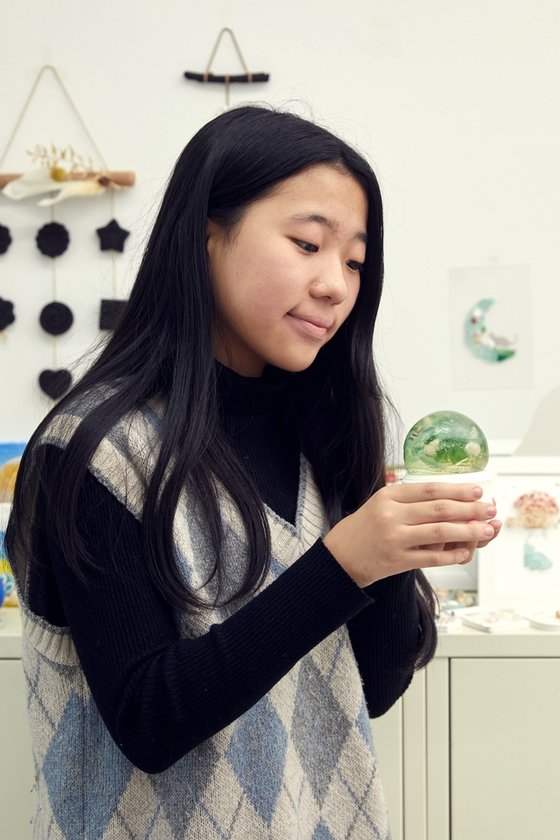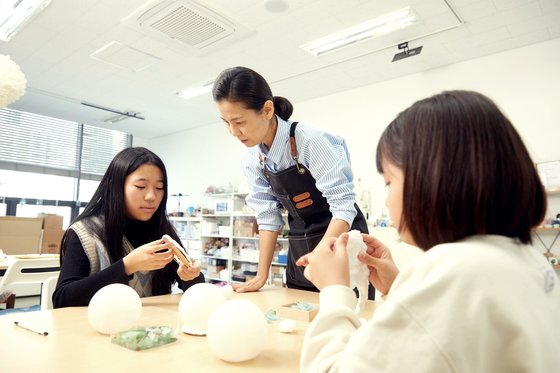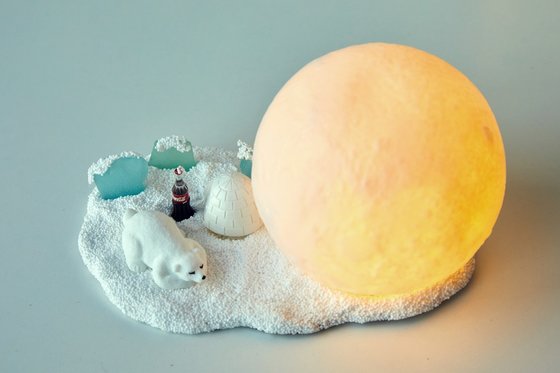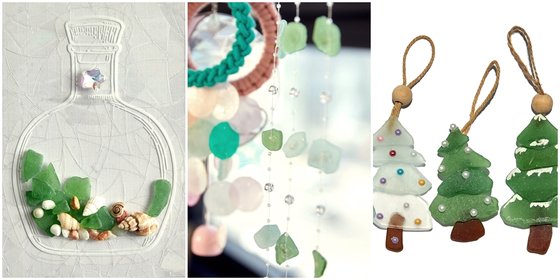In summer, when the hot sun beats down, you want to go on a trip to the beach. Enjoying a swim in the sea and taking a leisurely walk on the beach are the fun and romantic aspects of summer vacation. But have you ever thought about what the beach looks like after the summer vacation season? Unfortunately, trash left behind by travelers often litters the coast.
Student reporters Kwon Hye-won (left) and Seo Ji-an created an Arctic mood light using sea glass. Making crafts with beachcombing by-products not only promotes upcycling, but also draws attention to marine pollution.
The act of jogging and picking up trash to protect both your health and the environment is called plogging. As plogging became popular a few years ago, it became common to see photos of people participating in plogging holding garbage bags on social media or in various media, such as ‘Boys JoongAng’ plogging articles.
Similarly, you can also take a walk along the coast and pick up trash. Collecting marine debris like combing a beach is called beach combing. Beyond beachcombing, there are also activities that recycle collected trash into crafts. This is called beachcombing upcycling.
Student reporters Kwon Hye-won and Seo Ji-an visited the walking studio in Taejang-ro, Gimpo-si, Gyeonggi-do to experience beachcombing upcycling and met instructor Wang Yeong-sil. “I started making upcycling crafts with coastal waste from beachcombing three years ago to make people aware of the seriousness of marine waste.”
![[소년중앙] Let’s make cool crafts with trash picked up at the beach. [소년중앙] Let’s make cool crafts with trash picked up at the beach.](https://pds.joongang.co.kr/news/component/htmlphoto_mmdata/202411/11/bfaf204b-c03d-4e17-9d3e-f93fce66ec1b.jpg)
Sea glass with smooth edges due to weathering is suitable for upcycling, but glass with sharp edges must be collected separately.
Once coastal trash enters the sea, it becomes difficult to collect and can have a negative impact on marine life, so prompt detection and collection is important. However, Korea’s coastline, which is surrounded by sea on three sides, is 15,258 km long, and there are limits to monitoring with the local government’s ability to take charge of coastal waste. Therefore, in order to keep our country’s coasts clean, the active participation of the people is also important.
Instructor Wang showed part of the documentary ‘The Whale and I’ to the student reporters. A group of sperm whales were seen competing with each other to eat plastic bags floating in the sea, mistaking them for food. Although the production crew who was watching this incident collected plastic bags from the group of sperm whales, there is no guarantee that something like this will not happen again in a place where the production crew is not present.
“Marine life is the one that suffers the most from marine debris. You may have seen pictures of sea turtles suffering from straws stuck in their noses. Sea turtles swim in the sea and have to come out of the water to breathe. “It’s hard to breathe when trash like straws clog your nose. One of the ways we can help them is beachcombing.”

Student reporter Seo Ji-an looked at various types of sea glass that instructor Wang Yeong-sil picked up from various coasts across the country.
In addition to marine life, humans are also affected by marine debris. The World Wildlife Fund (WWF), a private nature conservation organization, estimated that humans ingest as much microplastics as a credit card (approximately 5g) every week. This is what happens when waste plastic that flows into the sea decomposes into microplastics, and the marine creatures that end up on our plates eat them. When marine life suffers, the damage ultimately returns to humans along the food chain.
Student reporter Jian asked, “What type of trash is most often found when the instructor goes beachcombing?” “I often go to the sea near Yeongjong Island in Incheon. There are a lot of people fishing there, so I often see fishing floats, fishing gloves, and plastic trash. Also, ashes that are not removed from campfires on the beach, fireworks materials, and glass fragments are also seen. “You can see a lot.”
Instructor Wang told the Sojo Student Reporters what precautions should be taken when beachcombing. When picking up trash on the beach, be sure to wear gloves and use tongs as there may be sharp pieces of glass. When picking up trash in the mudflats, you may end up going far out to sea. You need to check when the tide comes in and get out safely before the mudflats fill with water.

Student reporter Kwon Hye-won took a look at the snowball made using sea glass. Due to the nature of the material glass, it reflects light well, making it suitable for making snowballs.
Also, be careful not to dispose of trash soaked in seawater with regular trash because it contains salt. Marine waste is a mixture of various types of waste, and due to the high cost of sorting and post-processing, the recycling rate is low. So, it often goes to an incinerator, but because the salt often damages the equipment inside the incinerator, a separate procedure is required to clean the salt. Garbage soaked in seawater must be gathered together and then requested to be collected by the local government through the Safety Report Center.
Garbage and by-products obtained from beachcombing can be recycled into upcycling materials if you add some ideas. Mobiles are made by hanging seashells on driftwood (waste wood) that has washed up on the beach, and bags are made from waste nets and used for beachcombing. You can also make a chandelier using a float and a plastic lid.

Instructor Wang Young-sil (center) explained the concept and method of beachcombing and beachcombing upcycling to the student reporters.
Student reporter Hyewon was curious, “What materials do you often use for beachcombing upcycling crafts?” Instructor Wang pointed towards the wall of the workshop. There were various types of crafts on display, including mobiles, snowballs, and picture frames. What they have in common is that they use shiny green, brown, and light blue objects as materials. These things, which looked like pebbles and jewels, were actually pieces of glass that Instructor Wang had picked up from the sea.
“Glass bottles, etc. that flow into the sea are broken and chipped by weathering over a long period of time, forming glass pieces with round edges. They come in various sizes, colors, and shapes, and are also called ‘jewels of the sea’ because of their sparkling appearance. I’m being called.”
Sojoong’s student reporters decided to make a mood light resembling the North Pole using sea glass obtained through beachcombing. You will need a 10.6cm long x 17.2cm wide wooden board cut into a cloud shape with a hole on the left side, a battery-operated circular mood light, white foam clay, clean sea glass, and a polar bear model.

An arctic mood light made by decorating sea glass to look like an arctic glacier.
First, paste foam clay evenly on the cloud-shaped wooden board to represent the North Pole with snow. Then, place light blue sea glass on the other side of the hole in the wooden board and secure it with foam clay to create a glacier. Insert the bottom of the mood light into the hole on the left side of the wooden board and fix the position with foam clay. Lastly, place the polar bear model between the sea glass and the mood light to complete the Arctic mood light using sea glass. “Because the foam clay needs time to harden sufficiently, it must be dried well for at least 3 days to prevent the mood lights and props placed on the foam clay from falling off.”
Sojoong’s student reporters tried turning on the lights in a dark room. The circular mood light looked like a full moon at the North Pole. The glacier made of sea glass sparkled under the light of the mood lights.
However, not all glass pieces picked up from the beach can be used as materials for upcycling crafts. For the sea glass crafts made at the Walking Workshop, only glass whose edges have naturally become shiny due to weathering is washed to remove salt. If you see glass with sharp edges on the beach, it is best to pick it up with tongs and separate it for recycling.

Crafts made from glass pieces picked up at beachcombing. Because sea glass comes in a variety of colors, shapes, and sizes, it can be used to make various small items such as decorative picture frames, mood lights, mobiles, and key chains.
It’s amazing that trash picked up on the beach can be used as craft materials such as mobiles, mood lights, snowballs, and picture frames. By using the by-products obtained from beachcombing in this way as crafts, not only can we upcycle by adding value to discarded or useless materials, but we can also call attention to marine pollution.
Now, every time you go for a walk on the beach, why not take gloves, tongs, and a trash bag with you to pick up trash? Not only can you help keep our country’s coasts clean, but you can also find materials to make your own household items.
Companion reporting =Hyewon Kwon(Dangseo Elementary School 6, Seoul)·Seo Ji-an(Seoul Jamil Elementary School 5) Student Reporter
Beachcombing and coastal waste disposal methods

The Korea Marine Environment Corporation selects parts of Korea’s east, west, and south sea coasts and conducts regular coastal waste surveys once every two months. In 2023, a survey was conducted targeting 60 coastal areas. Let’s take a look at what types of trash are commonly found on our coasts.

Review of student reporter coverage
I really felt a lot while covering beachcombing upcycling. Seeing marine life mistaking trash abandoned in the sea for food made me realize once again how important nature protection is, and I was very impressed by the fact that discarded things can be turned into materials for art. I especially enjoyed the process of creating art using sea glass. The unique colors of each piece were truly beautiful. I began to think deeply about how the things we easily throw away in our daily lives affect the environment, and I also felt hope that small actions could create big changes. This interview was a truly meaningful experience as I was able to protect the environment and create beautiful works at the same time.
Hyewon Kwon(Dangseo Elementary School 6, Seoul) Student Reporter
I felt proud to learn about new environmental protection activities through this report. While experiencing beachcombing art at the walking workshop, I was amazed and amazed to see things that I thought were trash being reborn beautifully. I made an arctic mood light, using sky-blue sea glass to represent a glacier, and I also added a model of a Coke bottle to express the fact that the Earth is getting more and more sick due to the amount of trash floating in the ocean. As I was making it, I was reminded of the sad reality that glaciers are gradually melting due to global warming, sea levels are rising, and habitats for polar creatures are disappearing. At first, the words plogging and beachcombing were unfamiliar to me, but after hearing their meaning, I realized that they are experiences that we have already done at least once in our daily lives. After reporting, I asked my friend if he knew about plogging and beachcombing upcycling crafts, and he said it was his first time hearing about them. So, I thought that since the general public still lacks awareness of environmental protection activities such as plogging, beachcombing, and upcycling crafts, I should try to promote them more in the future. And next time I go to the beach, I want to try proper beachcombing. This is because beachcombing kills two birds with one stone: you can enjoy it as marine leisure and it can prevent environmental pollution.
Seo Ji-an(Seoul Jamil Elementary School 5) Student Reporter
Text = Reporter Seong Seon-hae [email protected], Photo = Lim Ik-soon (Open Studio)

